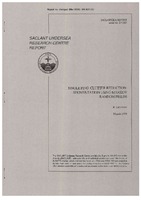| dc.description.abstract | The use of low frequency active sonar in shallow water leads to large numbers of clutter detections. This high false alarm rate can overload automatic tracking and classification algorithms. Traditional detection algorithms operate on each beam output individually searching for targets at all ranges. However, the target echo and bottom features may extend over several beams, either because a reflector is extended over space or because of the sidelobe structure of the beamformer. This suggest to associate detections over bearing, e.g. apply image processing to the range-bearing sonar data. This report describes an automatic method of image segmentation based on a Markov random field model to reduce clutter. The segmentation is treated as a labelling problem, i.e. assign to each rangebearing cell either a target-or background label. It removes small objects which do not exhibit the right signature over beams. Separate detections corresponding to one large reflector are clumped together to form one single object. Objects too large to be a submarine can then be removed. The Markov random field model uses a priori physical and probabilistic knowledge of the range-bearing sonar picture. It assumes that the background is Rayleigh distributed, a target has, on average, a large signal to noise ratio (SNR) and that the label at each range-bearing cell is influenced by its neighbouring cells. An iterative algorithm is used to produce a maximum a posteriori estimate for the labelling. The model parameters are tuned to remove as much clutter as possible without substantially reducing the probability of detection. The algorithm was tested over a large number of sonar images. The performance is determined using several measures of performance including probability of detection and number of false alarm objects, i.e. connected detections. The number of false alarm objects was reduced by almost an order of magnitude while retaining more than 90% of the target detections. To test the influence of target SNR on the segmentation, simulated sonar pictures, containing a target of known SNR, were produced. The algorithm performs well for high SNR targets but those with low SNR have lower detection probability. This is not a big problem as usually targets have sufficient SNR. | |
